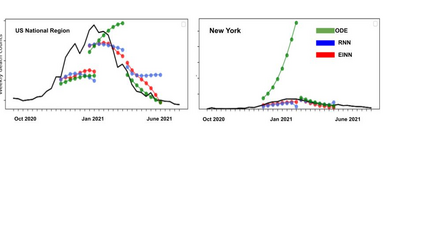We introduce a new class of physics-informed neural networks-EINN-crafted for epidemic forecasting. We investigate how to leverage both the theoretical flexibility provided by mechanistic models as well as the data-driven expressability afforded by AI models, to ingest heterogeneous information. Although neural forecasting models has been successful in multiple tasks, long-term predictions and anticipating trend changes remain open challenges. Epidemiological ODE models contain mechanisms that can guide us in these two tasks; however, they have limited capability of ingesting data sources and modeling composite signals. Thus we propose to supervise neural networks with epidemic mechanistic models while simultaneously learning their hidden dynamics. Our method EINN allows neural models have the flexibility to learn the disease spread dynamics and use auxiliary features in a general framework. In contrast with previous work, we not assume the observability of complete dynamics and do not need to numerically solve the ODE equations during training. Our thorough experiments showcase the clear benefits of our approach with other non-trivial alternatives.
翻译:我们引入了新型的物理知情神经网络-EINN, 用于流行病预测。 我们研究如何利用机械模型提供的理论灵活性和AI模型提供的数据驱动的表达性,以吸收各种信息。 虽然神经预测模型在多项任务中取得了成功,但长期预测和预测趋势变化仍然是公开的挑战。 流行病学模式含有能够指导我们完成这两项任务的机制; 但是,它们获取数据来源和模拟综合信号的能力有限。 因此,我们提议在同时学习其隐藏动态的同时,对带有流行机械模型的神经网络进行监督。 我们的方法EINN允许神经模型具有学习疾病传播动态和使用一般框架辅助特征的灵活性。 与以往的工作不同,我们并不承担完全动态的可视性,不需要在培训中用数字方式解决ODE方程式。 我们的彻底实验展示了我们与其他非三边替代方法的明显好处。







